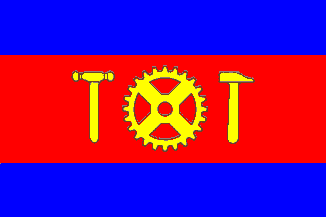 Shipmate Flagchart : http://www.flagchart.net
Shipmate Flagchart : http://www.flagchart.net
adopted 19 October 1956

FOTW beschäftigt sich mit der Wissenschaft der Vexillologie (Flaggenkunde).
Alle auf dieser Website dargebotenen Abbildungen dienen ausschließlich der Informationsvermittlung im Sinne der Flaggenkunde.
Wir distanziert uns ausdrücklich von allen hierauf dargestellten Symbolen verfassungsfeindlicher Organisationen.
Last modified: 2018-12-15 by rob raeside
Keywords: hoogezand-sappemeer |
Links: FOTW homepage |
search |
disclaimer and copyright |
write us |
mirrors
 Shipmate Flagchart : http://www.flagchart.net
Shipmate Flagchart : http://www.flagchart.net
adopted 19 October 1956
![[Hoogezand-Sappemeer Coat of Arms]](../images/n/nl-gr)hs.jpg) image from the municipal website.
image from the municipal website.
Granted 28 Nov 1951.
![[Hoogezand flag]](../images/n/nl-gr_hz.gif) by Jarig Bakker, 27 Aug 2003
by Jarig Bakker, 27 Aug 2003
On 1 Apr 1949 the municipalities of Hoogezand and Sappemeer (Groningen
province) merged to form the new municipality of Hoogezand-Sappemeer.
When Kl. Sierksma wrote "Nederlands Vlaggenboek" in 1962 the municipality
of Hoogezand had been dissolved, so it fell outside the book's scope. Recently
the flag was discovered; it had been adopted by municipal resolution 24
Jul 1929, but this resolution has not been written down. The flag was offered
by the local Tourist Board, based on the Coat of Arms of Hoogezand (which had been
granted 3 Dec 1902).
Description of the arms: gold with billeté black blocks, a black
cogwheel ; a red chief with a riveting-hammer between two affrontée
caulking-mallets, all gold; the shield surmontée a crown of three
leaves and two pearls.
The block are peat-blocks. The hammers represent the (wooden) ships,
which were built here; the cogwheel the engine-industry which developed
here in the early 1900's.
Description of the flag: a red hoist of 1/5 flaglength, charged with
a yellow hammer with its head towards the hoist, with above and below two
yellow caulking-mallets; the top one left-diagonal with its head down;
the bottom one right-diagonal with its head up; the fly with ten equally
wide horizontal stripes of brown and yellow, with in the center a black
cogwheel with 1/2 flagheight, surrounded by ten lying rectangular black
black blocks.
Brown is the color of the soil from which peat was dug; the blocks
the peat-blocks; the hammers represent shipbuilding; the cogwheel industry.
The red color symbolizes the "holy fire", which should inspire everybody
to work for the prosperity of Hoogezand.
Source: article by Hans van Heijningen in Vexilla Nostra, nr. 197,
1992.
Jarig Bakker, 27 Aug 2003
![[Sappemeer flag]](../images/n/nl-gr_sm.gif) by Jaume Ollé, 12 Aug 2003
by Jaume Ollé, 12 Aug 2003
Occasionally Jaume Ollé's series of images from Steenbergen's
book hits the Netherlands. Here is one depicting "Sappemeer", a town
in Groningen province, now part of the municipality of Hoogezand-Sappemeer,
noted for seafaring in the 19th century and shipbuilding (mainly coasters)
up till now.
The old Sappemeer flag is based on the local "Zeemanscollege", which
later (with some implements on the red stripe) became the municipal flag
of Hoogezand-Sappemeer, still in use.
Jarig Bakker, 12 Aug 2003
![[Flag of De Vooruitgang]](../images/n/nl~dvs.gif) by Jarig Bakker, 29 Jun 2003
by Jarig Bakker, 29 Jun 2003
Collegie "De Vooruitgang" (College "The Progress"), established 1827
in Sappemeer. It appears that neighbouring Hoogezand did not have its own
Zeemanscollege, as several Hoogezand captains are registered as members
of the Sappemeer college. Leen Smit pictures number 12. By 1979 this college
had disappeared.
Flag: Red with blue flywise edges, and a white number centered on the
red. (Drawn as appr. 1:4:1.).
Peter Hans van den Muijzenberg, 6 Dec 2001
In "De geschiedenis van het College Zeemanshoop 1822-1972", by Mr. J.H.van
den Hoek-Ostende is a plate with 13 flags of Zeemans Collegiën in
Nederland. For "De Vooruitgang" te Sappemeer the flag is hor. blue - red
- blue, with a white cipher 1 in the center. Stripes proportioned 1:2:1.
Jarig Bakker, 29 Jun 2003
![[Kiel-Windeweer flag]](../images/n/nl-gr_kw.gif) by Jarig Bakker, 8 Apr 2005
by Jarig Bakker, 8 Apr 2005
Kiel-Windeweer is a village in the municipality of Hoogezand-Sappemeer in Groningen province (not far from the German border). At this webpage is a weblog with an enthusiastic description of the village flag.
The Kielster Vlag
The Society for Village Interests asked in Nov 2003 for designs for
the village flag of Kiel-Windeweer. In March 2004 the Mayor, Mr. Koops,
revealed the winning design of Joachim Koops. The flag was taken in use
during the village party of May 2004.
The Kielster flag contains some symbolic elements referring to the
values characterising the village. Green is for the fields, yellow for
corn and roads (which used to be sandy) and blue for water. The three diagonal
conical stripes represent an abstract aerial view of Kiel-Windeweer, with
the central stripe as the Kieldiep (canal) between two sandy roads.
The stripes may also be viewed as symbol for the three different parts
of the village: Kiel-Windeweer, Nieuwe Compagnie and Lula. The stripes
converge in a vanishing-point in the top fly corner. This suggests perspective
and gives the impression of the endless length of the village.
The village is near the town of Veendam, which boasts a Soccerclub "FC
Veendam" with a stadium named "De Lange Leegte" (The Long Emptiness)...
Jarig Bakker, 8 Apr 2005
Excellent! One of the best village flags designed recently!
Hans van Heijningen, 8 Apr 2005
This reminds me of the flag of the Seychelles
- not original - no symbol present, so meaningless.
Willem van Ham, 8 Apr 2005
Actually a nice flag - for a polderboard!
Ralf Hartemink, 9 Apr 2005
Hosted by: Fanshop-Online.de und Handy-Shop.de
Tipp: Apple iPhone 12 im Shop